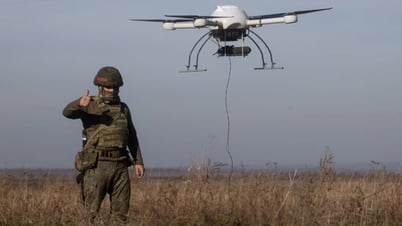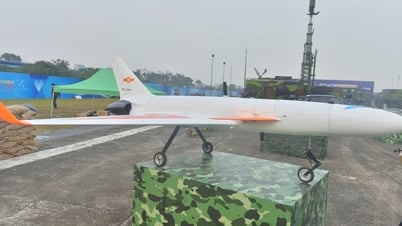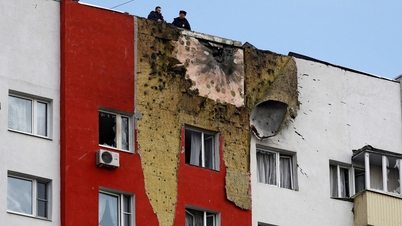The move shows that Moscow's stalled project has been "revived" to meet operational requirements in Ukraine.
Experts have long pointed out that Russia lacks medium and high altitude (MALE/HALE) combat drones that could achieve some significant battlefield objectives.
Reconnaissance combined with attack
The Sirius UAV, also known as Inokhodets-RU, was developed by the St. Petersburg-based Kronstadt Corporation. Intended for reconnaissance and attack roles, the Sirius is based on the Orion UAV, featuring two turbofan engines compared to the single engine on the American Reaper model. According to the manufacturer, the Sirius is capable of operating for 20 hours continuously.

In particular, the synthetic aperture radar (SAR) on this UAV model can detect moving targets and enemy activities on the ground regardless of thick clouds or poor visibility.
Information circulating on Russian Telegram groups suggests that the new UAV can reach a maximum altitude of 7,000 meters (23,000 feet), with a flight speed of 180 km/h and a range of 3,000 km. In addition, many sources say that the UAV is also equipped with its own satellite communication system.
Sirius can carry a total weapon weight (bombs/mines) from 300 kg to 400 kg. At the Army-2020 forum, the UAV model was displayed with many types of weapons such as guided bombs FAB-100, KAB-100, OFAB-250.
Some Russian military bloggers claim the Sirius can even carry conventional air-to-ground missiles and precision-guided weapons under its wings.

Due to its similarity to the US MQ-9 Reaper and RQ-4B Global Hawk UAVs operating in the Ukraine battlefield, observers are speculating about how this UAV model will be used by Russia in the near future.
Washington's UAVs, which regularly operate south of Crimea on the Black Sea, equipped with electronic support (ES) and optical reconnaissance equipment, have provided real-time intelligence, surveillance and reconnaissance (ISR) capabilities on the operation of air defense radars, naval and ground deployments from the Russian side.
Information from Reaper and Global Hawk is believed to have been the basis for attacks on Russia's Engels and Dyagilevo air bases last year (December 5 and 26), as well as suicide drone attacks on Moscow's Black Sea Fleet.
Shared data, increased combat capability
Analysts say the permanent presence of a heavy drone with powerful sensors capable of continuously monitoring ground movements in Ukraine from a safe distance inside Russian airspace would provide a wide range of options for Russian military planners.
The collected data can be shared with ground systems, or airborne platforms such as the Su-34, Su-35 and Su-30.

In theory, the Russian military's defense power will be significantly enhanced when attacks from Ukraine are detected early, creating a premise for counterattack plans to be implemented tightly and effectively.
In addition, the Sirius UAV can carry out attack and destruction missions after identifying targets with glide bombs without relying on the support of other ground or air vehicles.
EurAsianTimes said that a report from August 2022 showed that Russia is using Orion and Sirius UAVs in parallel as part of “manned reconnaissance and strike missions”.
With a satellite receiver that increases its operating range, the Sirius UAV is expected to significantly amplify the capabilities of other UAVs and manned jet fighters such as the Su-35 or Su-30.
Through data sharing and networking, fighter bombers can completely hand over ground surveillance tasks to drones, reducing the task of aerial scanning to focus on combat. Meanwhile, guided and unguided munitions on UAVs are an addition to the weapons load.
The West believes that Moscow could send Sirius into Ukrainian airspace as a "bait" to detect the location of S-300 air defense systems or Buk Radar SAM, before using Su-35s carrying Kh-31 anti-radiation missiles (ARM) to attack these systems.
(According to EurAsian Times)
Source



![[Photo] More than 17,000 candidates participate in the 2025 SPT Competency Assessment Test of Hanoi National University of Education](https://vphoto.vietnam.vn/thumb/1200x675/vietnam/resource/IMAGE/2025/5/17/e538d9a1636c407cbb211b314e6303fd)
![[Photo] Readers line up to visit the photo exhibition and receive a special publication commemorating the 135th birthday of President Ho Chi Minh at Nhan Dan Newspaper](https://vphoto.vietnam.vn/thumb/1200x675/vietnam/resource/IMAGE/2025/5/17/85b3197fc6bd43e6a9ee4db15101005b)


![[Photo] Prime Minister Pham Minh Chinh chairs meeting on science and technology development](https://vphoto.vietnam.vn/thumb/1200x675/vietnam/resource/IMAGE/2025/5/17/ae80dd74c384439789b12013c738a045)


























![[Photo] Nearly 3,000 students moved by stories about soldiers](https://vphoto.vietnam.vn/thumb/1200x675/vietnam/resource/IMAGE/2025/5/17/21da57c8241e42438b423eaa37215e0e)







































































Comment (0)